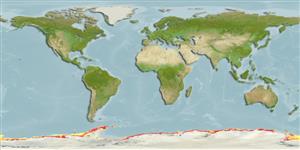>
Perciformes/Notothenioidei (Icefishes) >
Nototheniidae (Cod icefishes) > Trematominae
Etymology: Trematomus: Greek, trematos = hole + Greek, tomo = section, cut (Ref. 45335); bernacchii: Species name bernacchii honors Louis Bernarcchi, an Australian physicist-meteorologist; specimen collected on the Southern Cross Expedition and served on Scott's 1901 expedition (Ref. 45168).
More on author: Boulenger.
Issue
The genus Pseudotrematomus is a synonym of Trematomus, which is confirmed by a molecular study to be published (J.-C. Hureau, pers. comm. 08 Jun. 2010).
Environment: milieu / climate zone / depth range / distribution range
Ökologie
seewasser demersal; tiefenbereich 0 - 700 m (Ref. 11892), usually 0 - 200 m (Ref. 45168). Polar; 61°S - 78°S
Southern Ocean: Peter Island, South Shetland, Elephant and South Orkney islands. Mac-Robertson, Queen Mary, Adelie Coasts, Weddell, Davis and Ross seas. East Antarctica from Queen Maud Land to Terre Adelie.
Length at first maturity / Size / Gewicht / Alter
Maturity: Lm ?, range 18 - ? cm
Max length : 28.0 cm TL Männchen/unbestimmt; (Ref. 5179); 35.0 cm TL (female); common length : 25.0 cm TL Männchen/unbestimmt; (Ref. 2121); max. veröff. Alter: 10 Jahre (Ref. 5179)
Rückenflossenstacheln (insgesamt): 4 - 6; Rückenflossenweichstrahlen (insgesamt): 34-39; Afterflossenweichstrahlen: 31 - 35. Body brownish, large dark spots in two or three series on body. Spinous dorsal blackish in upper part (Ref. 11892).
Found in seafloors, well adapted to extremely low and stable temperatures (-1.86°C), annual mean temperature of McMurdo Sound) (Ref. 45168). Feed on polychaetes, gastropods, isopods, amphipods and few algae. Spawn once a year (Ref. 1071). Utilized for human consumption.
Although members of this Family are known to tend to egg masses, it is assumed that because of the high fecundity, this species is a non-guarder (RF), to be corrected if direct information becomes available.
Dewitt, H.H., P.C. Heemstra and O. Gon, 1990. Nototheniidae. p. 279-331. In O. Gon and P.C. Heemstra (eds.) Fishes of the Southern Ocean. J.L.B. Smith Institute of Ichthyology, Grahamstown, South Africa. (Ref. 5179)
IUCN Rote Liste Status (Ref. 130435)
Bedrohung für Menschen
Harmless
Nutzung durch Menschen
Fischereien: kommerziell
Mehr Information
ReferenzenAquakulturAquakultur ProfilZuchtlinienGenetikElectrophoresesVererbbarkeitKrankheitenVerarbeitungNutrientsMass conversion
PartnerBilderStamps, Coins Misc.LauteCiguateraGeschwindigkeitSchwimmstilKiemenoberflächeOtolithsGehirngrößeSehfähigkeit
Tools
Zusatzinformationen
Download XML
Internet Quellen
Estimates based on models
Preferred temperature (Ref.
123201): -1.8 - -0.8, mean -1.7 °C (based on 2076 cells).
Phylogenetic diversity index (Ref.
82804): PD
50 = 0.5005 [Uniqueness, from 0.5 = low to 2.0 = high].
Bayesian length-weight: a=0.00537 (0.00280 - 0.01029), b=3.24 (3.07 - 3.41), in cm total length, based on LWR estimates for this Genus-body shape (Ref.
93245).
Trophic level (Ref.
69278): 3.4 ±0.1 se; based on diet studies.
Generation time: 5.9 (2.0 - 12.2) years. Estimated as median ln(3)/K based on 11
growth studies.
Widerstandsfähigkeit (Ref.
120179): mittel, Verdopplung der Population dauert 1,4 - 4,4 Jahre. (K=0.19-0.91; tm=3-6; tmax=10; Fec=1,200-3,123).
Fishing Vulnerability (Ref.
59153): Moderate to high vulnerability (53 of 100).
Nutrients (Ref.
124155): Calcium = 31.4 [18.6, 70.0] mg/100g; Iron = 0.456 [0.206, 0.860] mg/100g; Protein = 17.3 [16.3, 18.4] %; Omega3 = 0.417 [0.228, 0.727] g/100g; Selenium = 15.4 [6.7, 32.6] μg/100g; VitaminA = 15.6 [3.5, 70.7] μg/100g; Zinc = 0.515 [0.356, 0.761] mg/100g (wet weight); based on
nutrient studies.
